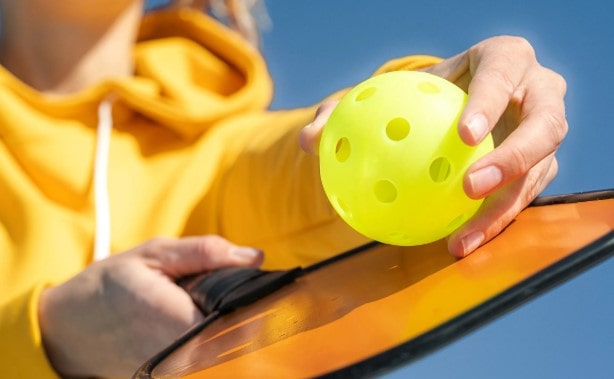Pickleball, a fast-growing sport enjoyed by millions worldwide, owes much of its popularity to its unique and dynamic gameplay. At the heart of this sport lies a small but crucial piece of equipment: the pickleball itself. Understanding how pickleballs are made reveals a fascinating combination of science, precision, and innovation. In this article, we’ll explore the step-by-step manufacturing process of pickleballs, from raw materials to finished products, and the meticulous standards that ensure they meet the demands of players and enthusiasts alike.
The Basics of a Pickleball: Materials and Structure

Before diving into the manufacturing process, it’s essential to understand what a pickleball is made of. Unlike balls in other sports, pickleballs are:
- Lightweight: Weighing between 0.78 and 0.935 ounces.
- Durable: Designed to withstand extensive use without breaking or deforming.
- Hollow: Made from high-quality, lightweight plastic.
Most pickleballs are crafted from polypropylene or polyethylene plastics, known for their durability, flexibility, and resistance to cracking.
Step 1: Material Selection and Preparation
The first step in how pickleballs are made involves selecting the right materials. Manufacturers source premium-grade thermoplastics, which are then melted and mixed with additives to enhance their strength and flexibility.
- Thermoplastics: The primary ingredient, which forms the ball’s base material.
- Color Pigments: To give the ball its distinctive colors, such as bright yellow, orange, or green.
- Stabilizers: Added to improve UV resistance and durability, especially for outdoor pickleballs exposed to sunlight.
Once the material mixture is ready, it is cooled and formed into pellets, making it easier to mold into the desired shape during the next step.
Step 2: Molding the Ball
The molding process is where the pickleball begins to take shape. Manufacturers use injection molding or rotational molding techniques, depending on the type of pickleball being produced.
Injection Molding
This method is commonly used for indoor pickleballs, which require smooth surfaces and precise dimensions:
- Heating the Pellets: The plastic pellets are melted into a molten state.
- Filling the Mold: The molten plastic is injected into a spherical mold.
- Cooling: The mold is cooled rapidly, allowing the plastic to harden into a hollow ball.
- Removing the Ball: Once cooled, the mold is opened, and the pickleball is extracted.
Rotational Molding
Outdoor pickleballs, which are often more durable, are made using rotational molding:
- Adding Material: Plastic powder is placed inside a hollow mold.
- Heating and Spinning: The mold is heated while being rotated in multiple directions, ensuring an even coating of plastic.
- Cooling: The mold is cooled to harden the material, creating a seamless and durable ball.
Step 3: Drilling the Holes
One of the defining features of a pickleball is its strategically placed holes, which influence its aerodynamics and flight characteristics. These holes are drilled using computerized machines to ensure precision and consistency.
- Indoor Pickleballs: Typically have fewer, larger holes to reduce drag and provide consistent flight indoors.
- Outdoor Pickleballs: Have more, smaller holes to withstand wind and maintain stability during outdoor play.
The number of holes can range from 26 to 40, depending on the type of pickleball.
Step 4: Quality Testing
After drilling, each pickleball undergoes rigorous quality testing to ensure it meets industry standards set by organizations like the USA Pickleball Association (USAPA). Key aspects tested include:
- Weight: Ensuring the ball’s weight falls within the official range.
- Bounce: Testing rebound height to ensure consistent play.
- Durability: Checking for resistance to cracking or deformation under stress.
Balls that fail to meet these standards are recycled or discarded, while approved ones move to the next phase.
Step 5: Polishing and Finishing
The final step in how pickleballs are made is polishing and finishing. This involves smoothing out any rough edges and applying a protective coating to enhance the ball’s durability and aesthetic appeal. The finished pickleballs are then sorted, packaged, and prepared for distribution.
Innovations in Pickleball Manufacturing
As the sport grows, so does the innovation in pickleball manufacturing. Recent advancements include:
- Smart Materials: Incorporating advanced polymers for better performance.
- Eco-Friendly Practices: Using recycled plastics and sustainable manufacturing techniques.
- Custom Designs: Developing balls tailored for specific playing conditions or player preferences.
These innovations ensure that pickleballs continue to meet the evolving needs of players while minimizing their environmental impact.
Conclusion
The process of how pickleballs are made is a testament to the blend of science, craftsmanship, and passion that drives the sport. From raw plastic materials to meticulously finished products, every step ensures that the balls meet the highest standards of performance and durability.
Thank you for taking the time to learn about the intricate process behind pickleball manufacturing. We hope this article provided valuable insights into the sport you love. For more tips and information, be sure to visit PickleballTips.org.
